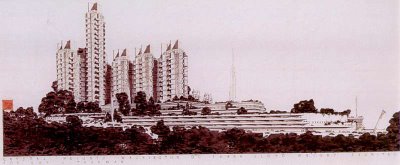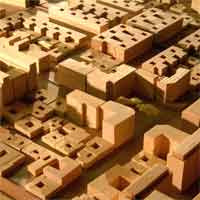Here's just some examples of a few urban housing types that are enormously popular overseas,
- Linked home units (e.g. 'sausage' blocks)
- Semi-detached housing units
- Four-storey walk-up apartments
- Multi-storey apartments with elevators
- Community housing, with shared courtyards, shared kitchen areas and the like
- Two, three, and four-storey terrace housing
- Courtyard housing, and courtyard clusters
- Mews housing
- Mixed-use four storey walk-ups
- innovative medium-density housing (such as Rotterdam's 'pole houses,' Frank Lloyd Wright's Suntop Homes and Crystal Heights apartments, San Francisco's Fulton Grove 'alley housing,' and Moshe Safdie's Habitat)
- Single family home on an eighth-of-an-acre section
 Now, with all these types of urban housing available, most of them enormously popular overseas (and some of them once very popular here), ask yourself how many of them a land-owner would be allowed to build on his typical bit of land in a typical NZ city...
Now, with all these types of urban housing available, most of them enormously popular overseas (and some of them once very popular here), ask yourself how many of them a land-owner would be allowed to build on his typical bit of land in a typical NZ city...If you guessed "not many," you'd be dead right.
 The answer (with rare exceptions) is that for most bits of land in most NZ suburbs, all of the housing types listed that make the least use of scarce urban land are allowed, and all those that help increase the number of housing units that can comfortably work in a city -- and that are enormously popular overseas -- almost all of these urban housing types are disallowed.
The answer (with rare exceptions) is that for most bits of land in most NZ suburbs, all of the housing types listed that make the least use of scarce urban land are allowed, and all those that help increase the number of housing units that can comfortably work in a city -- and that are enormously popular overseas -- almost all of these urban housing types are disallowed. Is this smart, do you think? People who complain about the number of single family homes that are built on eighth-of-an-acre sections right across NZ cities (which is mostly what NZ District Plans are written to protect) should direct their ire at those who ensure this is the only thing people are allowed to build: at the planners and the Resource Management Act that gives the planners their power.
Is this smart, do you think? People who complain about the number of single family homes that are built on eighth-of-an-acre sections right across NZ cities (which is mostly what NZ District Plans are written to protect) should direct their ire at those who ensure this is the only thing people are allowed to build: at the planners and the Resource Management Act that gives the planners their power.District Plans drawn up by planners place enormous restrictions on what one can do one one's own land, restricting choice and trampling over property rights -- but it's been going on for so long and with so little protest that most of these restrictions and the "right" of planners to impose them are simply taken for granted.
 Planners have placed restrictions on the height of what you can build, on the setbacks of new buildings from the street and from boundaries, and most importantly restrictions are place on the density of new building -- on the number of housing units one may build on one's own land.
Planners have placed restrictions on the height of what you can build, on the setbacks of new buildings from the street and from boundaries, and most importantly restrictions are place on the density of new building -- on the number of housing units one may build on one's own land. It is the restrictions on density that exert the biggest stranglehold on our cities. At a density similar to some of the better parts of London for example, with which many NZers are familiar, the population of Auckland could be easily fitted on the ishthmus, with plenty of land left over for parks, and plenty of land left over outside the isthmus for decreased densities if people so wish.
It is the restrictions on density that exert the biggest stranglehold on our cities. At a density similar to some of the better parts of London for example, with which many NZers are familiar, the population of Auckland could be easily fitted on the ishthmus, with plenty of land left over for parks, and plenty of land left over outside the isthmus for decreased densities if people so wish.Instead, the planners have ensured the city spreads slowly out into the country-side one relaxation of the ring-fence after another, creating the "carpet sprawl" that supporters of the Resource Management Act claim they dislike, and removing the chance of genuine country living for those who so desire it.
 In some parts of some NZ cities, further restrictions have been placed on land, protecting the cold and archaic early twentieth-century housing that still disgraces so much of the early urban landscape.
In some parts of some NZ cities, further restrictions have been placed on land, protecting the cold and archaic early twentieth-century housing that still disgraces so much of the early urban landscape. Planners have restricted the supply of urban land, making it even scarcer than it needs to be, and restricted the housing choices that New Zealanders are allowed to make to a one-size-fits-all bland-and-blander straitjacket, making urban space duller and even scarcer still.
Planners have restricted the supply of urban land, making it even scarcer than it needs to be, and restricted the housing choices that New Zealanders are allowed to make to a one-size-fits-all bland-and-blander straitjacket, making urban space duller and even scarcer still. What's wrong with choice? Why do we give these people such power? We let them ring-fence the city and stop people heading out and building away from the city when they want to -- "sprawl!" is the all-too hysterical cry -- and then we let them stop other people building higher density urban housing when they want to. Instead of leaving people free to choose, we have these boring "halfway houses" that some people like, but that many simply accept because that's all that's available, and they don't know any better.
What's wrong with choice? Why do we give these people such power? We let them ring-fence the city and stop people heading out and building away from the city when they want to -- "sprawl!" is the all-too hysterical cry -- and then we let them stop other people building higher density urban housing when they want to. Instead of leaving people free to choose, we have these boring "halfway houses" that some people like, but that many simply accept because that's all that's available, and they don't know any better.When there's just so much available from which to choose, it just doesn't make any sense.

1 comment:
I am pleased you included that photograph of part of Belgravia.
My favoured type of dwelling would be a 'Mews House', I think they look lovely, but alas finding something of that nature in Auckland seems difficult :P ...(cannot think why!)
Post a Comment